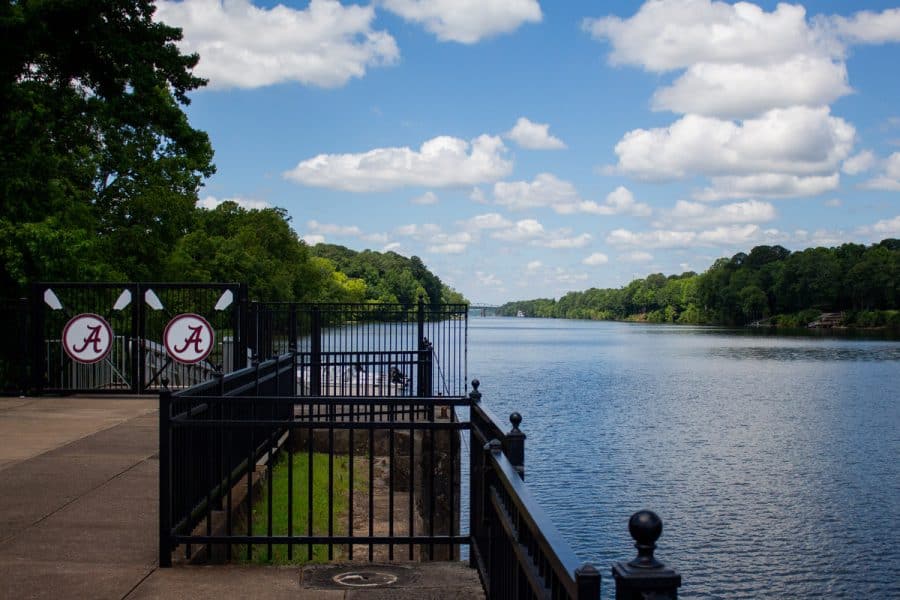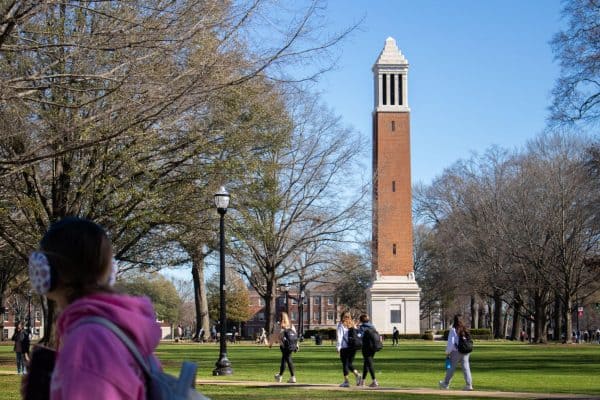Opinion | Protecting our waterways only benefits us
The Black Warrior River is one of the many bodies of water in Tuscaloosa, Ala.
June 7, 2023
When creating the Alabama state seal in 1817, Gov. William Wyatt Bibb wanted to cement Alabama’s most unique features into the design, forever highlighting their importance. At the time, he had no idea the Mobile River Basin covered two-thirds of the state and had a greater yield of water per square mile of land than all other basins in the United States.
Alabama boasts a remarkable myriad of waterways, freshwater and saltwater, widely considered some of the country’s most ecologically diverse. Before its statehood, Alabama rivers were used as a guide for trade routes and a source of food and water for Native Americans.
Since these developments, these rivers have determined patterns of settlements and commerce throughout the state’s history. People depend on these rivers for their way of life and livelihoods.
The primary water sources can be traced back to two sources: the Tennessee River drainage in North Alabama and the Mobile River Basin in Central Alabama, extending into the Gulf of Mexico.
The Tennessee River’s main stretch runs throughout Alabama, creating four reservoirs: Pickwick Lake, Wilson Lake, Wheeler Lake and Lake Guntersville, with a combined surface area of 195,200 acres. All are overseen and operated by the Tennessee Valley Authority.
TVA was created in 1933 after President Franklin Roosevelt’s New Deal was announced to address the valley’s issues regarding economic development. The preamble of the Tennessee Valley Authority Act expressed more specific desires like improving flood control, providing reforestation and electrifying the valley.
TVA worked with the region’s farmers to distribute powerful fertilizers to restore the farmlands and promote reforestation previously decimated by flooding. Thorough attention was given in developing their power plants, and the power produced by TVA was evenly distributed across the valley, attributing to the modernization of rural areas. The main goal was and continues to be to keep rates low and allow access for all.
People began utilizing the water by building dams and waterwheels to harness the power of these waterways to grind corn, saw lumber and spin cotton. Now these same key waterway uses that revolutionized commerce in Alabama could be at risk in the future.
Population and industrial growth create an influx of chemical dumping, and the unpredictability of interstate water disputes puts our systems and protected wetlands on the chopping block. This creates issues not only for wildlife but for the communities that also get their drinking water from these rivers.
In 2021, the city of Decatur, Morgan County and Decatur Utilities received a $98.4 million settlement from 3M, whose plant is located along the northern stretch of the Tennessee River. 3M had been responsible for dumping forever chemicals into its local waterways. “Forever chemicals” is the overarching name for a class of chemicals called PFAS, or per- and polyfluoroalkyl substances, which are used to create nonstick coatings on cookware, stain-resistant coatings on carpets, and fire-fighting foams, in addition to various other commercial uses. While Decatur is home to one of the region’s most efficient water treatment plants, the effects of PFAs have been detrimental.
Due to the widespread usage of PFAS, many of these chemicals are found in the blood of people and animals. While there is evidence of harmful side effects such as higher risks of some cancers and development issues for infants, there are thousands of PFAS, making it increasingly difficult to study all of the long-term health and environmental risks.
While Alabama is home to some of the richest biodiversity in its systems, in 2021 we had the highest rate of extinction. Twenty-three proposed new extinctions were announced in 2022. Half of these species are found in the Southeast. Alabama is home to nine.
Among these are 11 birds, eight freshwater mussels, a bat, a plant and two fish species. Our region is known for its mussel diversity, but due to river dams and mud pollution, the filter feeders that once kept our rivers clear and running have faltered. The rivers continue to darken.
Many mussel species thrive in habitats with clean water and gravel or sandy bottoms, which were prevalent in our waterways before the damming initiatives of the twentieth century. Since then, the bottoms of the reservoirs created by dams are often covered in mud, and mussels cannot live in these habitats any longer.
Mussels that can adapt to these conditions have become more prevalent, but we have lost many species along the way. Sedimentation and water pollution have claimed the existence of 27 species believed to be extinct and 22 species that no longer occur here but have been found in other areas. Forty-five are considered federally threatened and 40 are imperiled.
Currently, only 38 species in the state are considered stable.
As of April 12, 2022, the aquatic life that’s still alive is contaminated. There are 200 fish consumption advisories in the state. Pollutants build up in the fatty tissues of fish and can then be transferred to the human body, where they continue to build up. One of the most common in Alabama rivers is mercury, which originates from pollution and natural sources, such as coal.
In the 1880s the United States government began developing coal industries in Alabama and started by building a system of locks and dams. The stretch of the Black Warrior River is nearly entirely impounded to form a chain of reservoirs that yields hydroelectric power, drinking water and industrial water.
Tuscaloosa County is home to one of the last remaining large-scale metallurgical, or met, coal mines in the United States. Warrior Met Coal, the company that oversees the mining in Tuscaloosa County, is currently in the midst of a $500 million expansion of their mines, set to finish in 2025.
Just a few miles away sits the James H. Miller Jr. Electric Generating Plant, the coal-fired electrical generation facility. In 2017, the Environmental Protection Agency cited it as the largest emitter of greenhouse gases in the United States. In 2015, the most recent year for which data is available, Plant Miller emitted more than 19 million metric tons of pollutants.
When they’re not emitting pollutants, Plant Miller and Warrior Met Coal continue to contribute to the darkening of the Black Warrior. Industrial plants like these require large amounts of water either to create their products or to cool the machines that create their products.
Industrial water comes into contact with heavy metals and harmful chemicals and is then dumped into open rivers for disposal. Pollution ensues and biodiversity suffers greatly.
The Black Warrior River serves as a major source of drinking water for surrounding cities such as Birmingham and reaches as far as Cullman.
Our waterways statewide are under attack from the inside, and without the proper care taken, we’re at risk of losing the natural resources they provide. Our wildlife is dying. How much further is the state ready to let this go?











